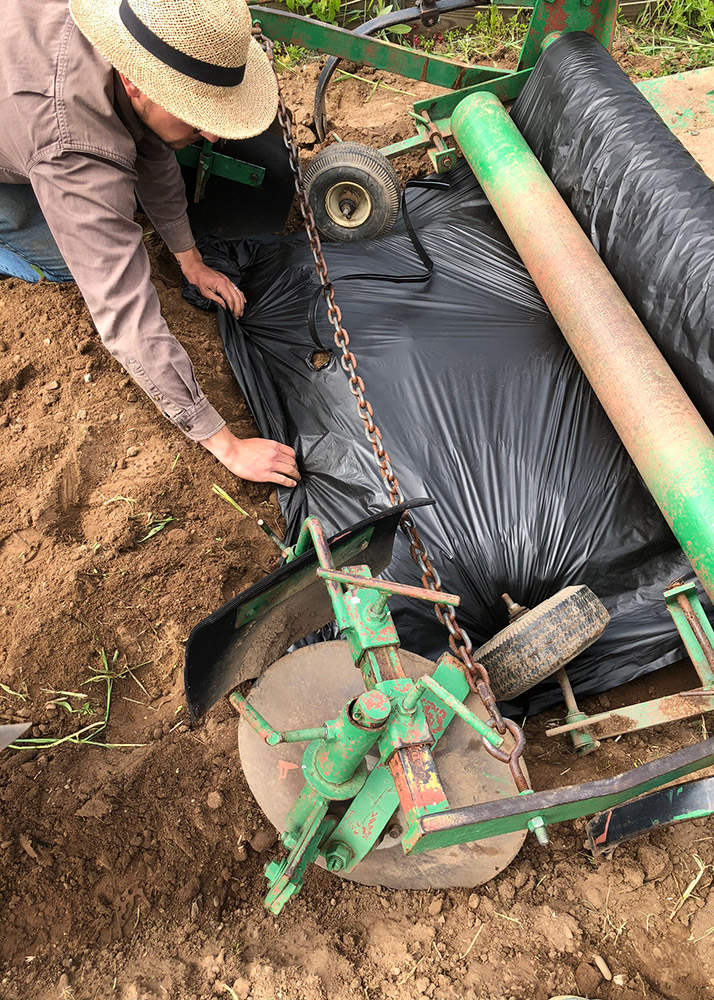Multidisciplinary project studies degradable mulching films
From left, Chad Kirby of Kirby Farms, Elizabeth Buck of Monroe County Cornell Cooperative Extension, RIT’s Carlos Diaz-Acosta, and Cornell Cooperative Extension’s Emma van der Heide discuss a field trial during the collaborative research project.
A federal grant matched by New York state and RIT is enabling university researchers to study a competitive solution to polyethylene mulch and identify a more sustainable alternative to conventionally used plastics in farming.
The Foundation for Food and Agriculture Research (FFAR) has awarded the university a $779,982 grant, which was matched with $334,355 in funding from the Empire State Development’s (ESD) Division of Science, Technology and Innovation program and $445,627 from RIT to study the use of degradable mulching films.
During a 2019 visit to Kirby Farms in Brockport, N.Y., RIT researchers observed Chad Kirby laying down polyethylene mulch film.
“While there are a number of biodegradable films available today, they have not been heavily adopted—particularly here in the United States,” said principal investigator Carlos Diaz-Acosta, associate professor of packaging science in RIT’s College of Engineering Technology. “The main reason is these plastic films don’t degrade in the timeframe promised, producing harmful landfill emissions for the environment, contaminated soil, and unnecessary transportation costs for growers.”
The idea of using polyethylene film as mulch in plant production dates back to the 1950s. Thousands of square miles of agricultural land today utilize polyethylene mulch for crop production worldwide. Over the last several decades, however, polyethylene—the polymer used for such things as grocery bags, shampoo bottles, and children’s toys—has become an environmental plague throughout the planet.
The goal of the four-year research project is to develop an economical alternative to polyethylene mulch in the form of a biodegradable plastic mulch that maintains a conducive climate for plant growth; has flexibility to allow mechanical installation; remains intact during cropping season; uses a trigger mechanism (such as spraying) to activate accelerated biodegradation; and undergoes complete biodegradation after tilling into soil.
“RIT has a long history of working collaboratively with the farming community to identify methods designed to achieve more sustainable agricultural practices,” said Ryne Raffaelle, RIT’s vice president for research and associate provost. “These grants from FFAR and ESD are much appreciated as they will enable RIT researchers to look at innovative new ways to eliminate the harmful environmental impacts of landfilling and incineration when it comes to these plastic films.”
In addition to Diaz-Acosta, co-principal investigators for the multidisciplinary project include Thomas Trabold, associate professor and Sustainability Department head, Golisano Institute for Sustainability; Jeffrey Lodge, associate professor, Thomas H. Gosnell School of Life Sciences, College of Science; and Christopher Lewis, assistant professor, Department of Manufacturing and Mechanical Engineering Technology, College of Engineering Technology.
According to Trabold, the project will fill research gaps in understanding the properties of bioplastic materials that enable enhanced degradation under aerobic conditions in soil by modifying the bioplastic material formulation and move toward solutions using “triggers.”
Among the methods to help kickstart degradation will be the utilization of “biochar,” a high-carbon, fine-grained residue derived from thermochemically treating organic biomass to improve agriculture production.
“By returning organic carbon to the soil, we’re confident that it will improve soil health,” Trabold said.
Using biochar in combination with bioplastics marks an evolution of research that Diaz-Acosta and Trabold—in conjunction with the New York State Pollution Prevention Institute (NYSP2I)—are already working on to develop bioplastic packaging materials suitable for aerobic and/or anaerobic degradation when combined with food scraps to reduce waste to the landfill.
Their latest collaborative research will utilize field trials conducted with Cornell Cooperative Extension of Monroe County at farms nearby RIT, and in the American Packaging Corporation Center for Packaging Innovation on the Henrietta campus. Additional partners include Wegmans Food Markets.
RIT researchers will now aim to create agricultural films that can perform during the growing season and then “truly disappear” once the season ends, Diaz-Acosta said.
“That’s the panacea we are seeking to achieve here,” he said.














